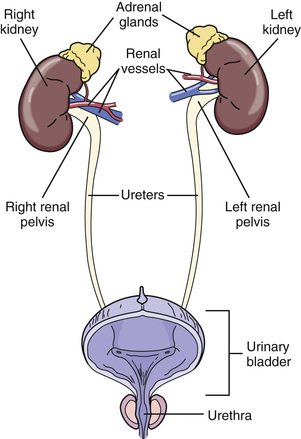Urinary and Reproductive Disorders
Objectives
• Define the key terms and key abbreviations in this chapter.
• Describe the care required for urinary tract infections.
• Describe the care required for prostate enlargement.
• Describe the care required for urinary diversions.
• Describe the care required for renal calculi.
• Describe the care required for acute and chronic kidney failure.
• Describe the care required for sexually transmitted diseases.
• Explain how to promote PRIDE in the person, the family, and yourself.
Key Terms
Urinary and reproductive disorders are common. Understanding the disorders gives meaning to the required care.
Urinary System Disorders
Disorders can occur in urinary system structures—kidneys, ureters, bladder, and urethra. Men can develop prostate problems.
See Body Structure and Function Review: The Urinary System, p. 750.
Urinary Tract Infections
Urinary tract infections (UTIs) are common. Infection in 1 area can spread through the urinary tract. Microbes can enter the system through the urethra. Urological exams, intercourse, poor perineal hygiene, immobility, and poor fluid intake are common causes. Persons with urinary catheters are at high risk (Chapter 25). UTI is a common healthcare-associated infection (Chapter 16).
Women are at high risk. Microbes can easily enter the short female urethra. Prostate gland secretions help protect men from UTIs. However, an enlarged prostate increases the risk of UTI.
See Box 47-1 for the types of UTIs and their signs and symptoms. UTIs are treated with antibiotics. Fluids are encouraged—usually 2000 mL (milliliters) a day. Normal elimination is promoted. The person should urinate when the urge is felt. For prevention and treatment, proper perineal care and catheter care are needed.
Prostate Enlargement
The prostate is a walnut-shaped gland in men. It lies in front of the rectum and just below the bladder (Fig. 47-2, A). The prostate surrounds the urethra. The prostate grows larger (enlarges) as the man grows older (Fig. 47-2, B). This is called benign prostatic hyperplasia (BPH). Benign means non-malignant. Hyper means excessive. Plasia means formation or development. Benign prostatic hypertrophy is another name for enlarged prostate. ( Trophy means growth.)
BPH is common in older men. The enlarged prostate presses against the urethra, obstructing urine flow. Bladder function is gradually lost. These problems are common.
• Trouble starting a urine stream
• Frequent voidings of small amounts of urine
• Urgency and leaking or dribbling of urine
• Frequent voiding at night (nocturia)
• Urinary retention (The man cannot void. Urine remains in the bladder.)
For mild BPH, drugs can shrink the prostate or stop its growth. Some microwave and laser treatments destroy excess prostate tissue.
Transurethral resection of the prostate (TURP) is a common surgical procedure for severe BPH. Inserted through the penis, a lighted scope with a wire loop is used to cut tissue and seal blood vessels. The removed tissue is flushed out of the bladder. Flushing fluid enters the bladder through a catheter. Urine and the flushing fluid flow out of the bladder through the same catheter. Some bleeding and blood clots are normal. The person’s care plan may include:
Urinary Diversion
Cancer and bladder injuries are common reasons for surgical removal of the bladder. With the bladder removed, urine must still leave the body. A urinary diversion is a surgically created pathway for urine to leave the body.
Often an ostomy is involved. A urostomy is a surgically created opening (stomy) that connects to the urinary tract (uro). The 2 main types of urostomies are:
• Ileal conduit. A small section of the small intestine (ileal) is re-positioned to serve as a channel (conduit) for urine. The ureters are connected to the conduit and the conduit is connected to a stoma (Fig. 47-3, p. 752).







